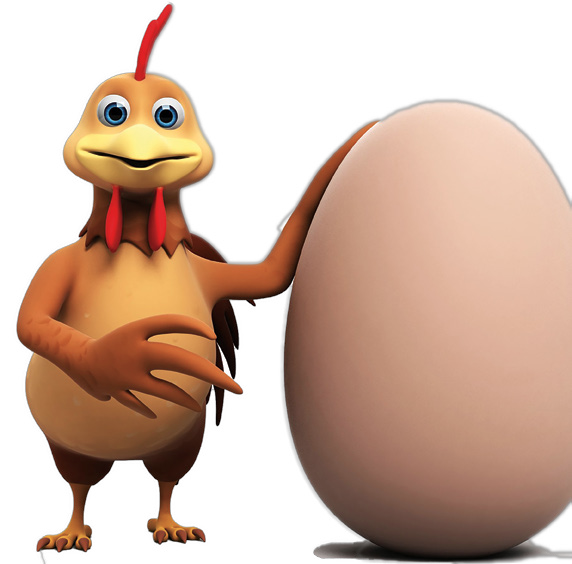No, I am not rewriting the Chinese astrological calendar, and it is still officially the Year of the Snake. However, in a satellite and broadcasting industry that is under highly disruptive change, I do wonder what the New Year will bring to us all.

In the beginning, there was television. OK, maybe not the exact beginning. Maybe just sometime during the last millennium. Really, really close to the end of that millennium. Like in the last six percent of that millennium. Either way, television as we have known it is in for dramatic changes. This is where the Chicken and Egg come into the picture.
As I've previously written, UHDTV is the latest digital video television standard that greatly expands the realism of our TV experience. UHDTV comes in two flavors: The 4K version (which, as it doubles the frame rate, will actually carry 8x more video information and which we will hear about for another year before most consumers actually see it), and the 8K variant (which carries 16x the video information) and is scheduled to show up in Japan by 2020. So much for simple-to-understand terms.
The big question remains as to where and when the entire UHDTV ecosystem will come together. The Egg side of the equation is driven by the television set manufacturers in Japan, Korea and China, who need to keep factorieshumming after selling us all the plasmas, LCD and LED TV's we could possibly ever want. And trying to talk us into 3DTV's, which, if they weren't generally good regular HDTV's, would quickly be going the way of the eight-track audio player.
Still, the TV set guys really, really need to drive the display market—and indeed they will. Let the marketing hype begin. Weall need 84-inch and 100-inch televisions. Only, well, some of us need a 100-inch door to fit them in. And maybe a wall big enough to put it on.
Still, the price of first-generationUHDTV sets is alreadylower than what we paidfor first-generation HDTV sets less than a decade ago. Morethan a dozen models are offered for sale today, and within the next two years you can expect mostnew sets sold will be "UHDTV ready." So, theEgg will have done its part. But where are the Chickens?
I really am a big fan of UHDTV. The imagescan be truly immersive and can give the "you ate there" experience.. But like the old joke about 300 channels on TV, but nothing to watch, the problem today is that there are no announced plans for any of today's giants in linear television distribution to launch UHDTV channels. No live sports channels. No live movie services. And, except for Japanese public broadcaster, NHK, no terrestrial networks. There isn't even an Aquarium Channel to watch colorful fish you never have to feed and never have tochange the water.
Simply blowing up today's HDTV images four times larger is a stupid pet trick that will get old pretty fast. So the Chickens in this allegory are, of course, the linear television networks, who of course have quite legitimate reasons why they aren't rushing intoa potential UHDTV Fool's Paradise.
As I write this article, UHDTV goes nowhere without a simpler and more economical means to transport it over satellite, broadband or terrestrial networks. First and foremost, there isn't even an "official" standard for how to carry UHDTV signals (natively eight times larger than HDTV signals) over HEVC (which will reduce that bandwidth by roughly half) yet. That finalization of the standard will arrive in early 2014.
Oh, and one little problem with the HEVC is that it is written largely to support the “progressive” versus the “interlace” video systems. Progressive, as many know, refers to one full frame of video following another, while the interlace standard transmits essentially half the information twice as often. While most would agree that high frame rate progressive is indeed the television production medium of the future, roughly 70 percent of the world’s programming is still produced in interlaced formats—that won’t change for another equipment-replacement lifetime. (Depending on who you ask, a “lifetime” in television is two seconds of dead air, a decade, or all of eternity; for this article, I’m going for the ten year definition).
My company, ATEME, is not just a leader in UHDTV over HEVC encoding, but also has been a strong advocate for inclusion of interlace within the HEVC encodingstandard. Tools will exist to support interlace within the new UHDTV/HEVC. Good.
However, the industry still hasn’t actually defined a single wire interface for either encoders or the television displays. Today we all do UHDTV with four inputs into the encoders, four inputs into the display devices. It works for our “science projects” but is wildly impractical for broadcasters and consumers alike. Most television networks have barely paid off the costs of the standard definition to HDTV transition.
While we do have first-generation UHDTV cameras (and quite a few movie studios and producers of episodic television series are starting to originate productions in UHDTV forat least their program masters and for their libraries), what we don’t have is a complete ecosystem of graphics, slow-motion, replay and other keycomponents to support live UHDTV sports production, without a doubt the biggest driver for UHDTV adoption. Similar to HDTV and 3DTV, most programmers have not yet figured out how to charge more to advertisers or subscribers for all the costs developers must bear to provide improved television pictures to their audiences. So, don’t blame the Chickens. They are a lot smarter than they look.
As the saying goes, "nature fills a vacuum." If our "Egg" display manufacturers are running hard, and our "Chicken" programmers are dragging their feet, who is to fill the gap between them? If industry rumors hold any value, it will be the non-linear Over The Top (OTT) entrants,
such as Netflix, Amazon and Hulu, who will get this UHDTV party started.

Unlike our friends in the DTH, Cable TV and traditional over-the-air broadcasts markets (who really don’t have a means of fitting UHDTV signals into their existing channel bandwidth today), the OTT players have an easier path to market. It’s called broadband Internet. Non-linear “file” delivery for movie and episodic television doesn’t require “new” bandwidth to deliver UHDTV television shows. You can do it today with products ATEME and other manufacturers produce. As with today’s file-based movie and television show delivery services, consumers can simply download files directly to the new “Smart TV’s.”
Yes, the files are larger and will take longerto download, but for early adopters who just plunked down $5,000 or more to be the first house on the block with a shiny new UHDTV set, this will be the first commercially available content they will find. With the new HEVC standard, and the improving broadband connectivity to consumers across the globe, launching or extending these services over the public Internet is possible and is widely accepted by consumers as well as by those who provide this connectivity; the cable and telco networks. It has become almost a “if we can’t beat them, jointhem” approach.
With terrestrial broadcasters (who as of today really don’t have the spectrumto support UHDTV signals) on the sidelines, and with the DTH and Cable TV distribution platforms facing “cord cutting” challenges to their traditional linear programming business models, will it be the OTT provider that fill the breach?
Quite possibly, will they allow the OTT “Fox” to run amok in the Chicken’s henhouse? If so, then just maybe 2014 will be known as the Year of the Fox...

Will the display manufacturers lay an Egg, and UHDTV fall as flat as Humpty Dumpty? Will the television platform operators and terrestrial broadcaster stay Chicken, or will they jump into the contest? Or, will they be outfoxed by the OTT platforms? Stay tuned—2014 looks to be a most interesting year.
About the author
Mike Antonovich has spent more than three decades in the broadcast, satellite, video fiber and video encoding marketplace. The opinions expressed in this article are his own, as nobody can put words in his mouth, nor shut him up. He presently serves as SVP & GM, Americas, for ATEME, and would be happy to have you inform his opinions on the future of our industry or just maybe sell you a video encoder.He can be reached at mike.antonovich@ateme.com

